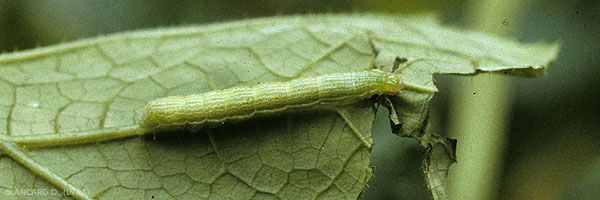
Moths (noctuids)
The aerial organs of the melon are liable to be devoured by the stage caterpillar of several more or less polyphagous Lepidoptera. These insects belong to various families, especially noctuids . Among these are Autographa gamma (L.) (figure 1), Chrysodeixis chalcites (Esper), Helicoverpa armigera (Hübner), Lacanobia oleracea (L.) and Spodoptera exigua (Hübner). We find these moths ( loopers ), and many others, in many production areas around the world where they sometimes cause considerable damage in field crops, as well as under cover.
- Nature of damage
It is the larvae, especially the older ones, that cause damage by consuming the leaf blade. This results in the presence of numerous more or less regular perforations located on the limbus or at its periphery (figure 1). The leaflets are eventually more or less sifted, perforated, cut .
- Biology
Lepidoptera go through 4 stages of development: egg, larva or caterpillar, pupa or chrysalis, and butterfly (figure 2).
- Forms of conservation and / or alternative hosts : most of these butterflies hibernate through pupae, or even larvae, although other stages of development may contribute to the winter conservation of these insects. They can be hosted by many cultivated and non-cultivated hosts.
- Developmental stages : the eggs (figure 7-1), transparent, white, black-brown, mauve, etc., with a diameter of less than a millimeter, are deposited singly or in groups on the surfaces of the leaves or various supports (figure 3 ). Subsequently, they hatch and give birth to caterpillars (figure 7-2) measuring 25 to 50 mm depending on the species, equipped with powerful mandibles that allow them to constantly consume plants, especially leaves (figures 3 and 5 to 7).
These caterpillars, of variable color (green, sometimes becoming brown to reddish with age), moult several times, before pupation or pupae. The pupae (Figure 7-3), which measure from 2 to 2.8 cm and on which we can clearly see the sheaths of the legs and wings as well as the abdominal segmentation, are reddish-brown in color. The adults (figure 7-4) are butterflies with 2 pairs of wings and whose wingspan varies from 25 to 45 mm for the species of interest to us. The fore and hind wings present a variable coloring according to the species (reddish brown, brown, gray ), as well as more or less characteristic patterns (figure 4).
The duration of their cycle varies depending on the temperature, from ten days to several weeks. The caterpillars are mobile and move easily from one leaflet to another like the adults who do so more easily. We should add that the reduction in soil disinfection practices seems to be contributing to the resurgence of this pest, on vegetable crops among others.
- Forms of conservation and / or alternative hosts : most of these butterflies hibernate through pupae, or even larvae, although other stages of development may contribute to the winter conservation of these insects. They can be hosted by many cultivated and non-cultivated hosts.
- Developmental stages : the eggs (figure 7-1), transparent, white, black-brown, mauve, etc., with a diameter of less than a millimeter, are deposited singly or in groups on the surfaces of the leaves or various supports (figure 3 ). Subsequently, they hatch and give birth to caterpillars (figure 7-2) measuring 25 to 50 mm depending on the species, equipped with powerful mandibles that allow them to constantly consume plants, especially leaves (figures 3 and 5 to 7).
These caterpillars, of variable color (green, sometimes becoming brown to reddish with age), moult several times, before pupation or pupae. The pupae (Figure 7-3), which measure from 2 to 2.8 cm and on which we can clearly see the sheaths of the legs and wings as well as the abdominal segmentation, are reddish-brown in color. The adults (figure 7-4) are butterflies with 2 pairs of wings and whose wingspan varies from 25 to 45 mm for the species of interest to us. The fore and hind wings present a variable coloring according to the species (reddish brown, brown, gray ), as well as more or less characteristic patterns (figure 4).
The duration of their cycle varies depending on the temperature, from ten days to several weeks. The caterpillars are mobile and move easily from one leaflet to another like the adults who do so more easily. We should add that the reduction in soil disinfection practices seems to be contributing to the resurgence of this pest, on vegetable crops among others.
- Protection methods
Several protection methods are recommended to control the development of noctuids on melon in France:
- install canvases insect-proof at shelter openings;
- install pheromone traps outside the shelter;
- use auxiliaries , these are the following micro-organisms: Bacillus thuringiensis subspecies azawai and Bacillus thuringiensis subspecies kurstaki ;
- consider chemical protection * ( e-phy ), in particular if you use auxiliaries.
* Chemical control : The number of pesticides available for a given use is constantly changing, we advise you to always confirm your choice by consulting the e-phy site of the Ministry of Agriculture and Fisheries which is a catalog in line of plant protection products and their uses, fertilizers and growing media approved in France. This also applies to all biological products based on microorganisms or natural substances.
- install canvases insect-proof at shelter openings;
- install pheromone traps outside the shelter;
- use auxiliaries , these are the following micro-organisms: Bacillus thuringiensis subspecies azawai and Bacillus thuringiensis subspecies kurstaki ;
- consider chemical protection * ( e-phy ), in particular if you use auxiliaries.
* Chemical control : The number of pesticides available for a given use is constantly changing, we advise you to always confirm your choice by consulting the e-phy site of the Ministry of Agriculture and Fisheries which is a catalog in line of plant protection products and their uses, fertilizers and growing media approved in France. This also applies to all biological products based on microorganisms or natural substances.





